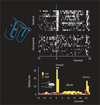Distributed neural networks of tactile working memory
- PMID: 23792021
- PMCID: PMC3844104
- DOI: 10.1016/j.jphysparis.2013.06.001
Distributed neural networks of tactile working memory
Abstract
Microelectrode recordings of cortical activity in primates performing working memory tasks reveal some cortical neurons exhibiting sustained or graded persistent elevations in firing rate during the period in which sensory information is actively maintained in short-term memory. These neurons are called "memory cells". Imaging and transcranial magnetic stimulation studies indicate that memory cells may arise from distributed cortical networks. Depending on the sensory modality of the memorandum in working memory tasks, neurons exhibiting memory-correlated patterns of firing have been detected in different association cortices including prefrontal cortex, and primary sensory cortices as well. Here we elaborate on neurophysiological experiments that lead to our understanding of the neuromechanisms of working memory, and mainly discuss findings on widely distributed cortical networks involved in tactile working memory.
Keywords: Monkey; Single unit recording; Somatosensory; Tactile; Working memory.
Copyright © 2013 Elsevier Ltd. All rights reserved.
Figures





Similar articles
-
Sequential roles of primary somatosensory cortex and posterior parietal cortex in tactile-visual cross-modal working memory: a single-pulse transcranial magnetic stimulation (spTMS) study.Brain Stimul. 2015 Jan-Feb;8(1):88-91. doi: 10.1016/j.brs.2014.08.009. Epub 2014 Sep 4. Brain Stimul. 2015. PMID: 25278428
-
Persistent neuronal firing in primary somatosensory cortex in the absence of working memory of trial-specific features of the sample stimuli in a haptic working memory task.J Cogn Neurosci. 2012 Mar;24(3):664-76. doi: 10.1162/jocn_a_00169. Epub 2011 Nov 18. J Cogn Neurosci. 2012. PMID: 22098263
-
Neural correlates of spatial working memory in humans: a functional magnetic resonance imaging study comparing visual and tactile processes.Neuroscience. 2006 Apr 28;139(1):339-49. doi: 10.1016/j.neuroscience.2005.08.045. Epub 2005 Dec 1. Neuroscience. 2006. PMID: 16324793
-
Distributed memory for both short and long term.Neurobiol Learn Mem. 1998 Jul-Sep;70(1-2):268-74. doi: 10.1006/nlme.1998.3852. Neurobiol Learn Mem. 1998. PMID: 9753601 Review.
-
Prefrontal cortex and working memory processes.Neuroscience. 2006 Apr 28;139(1):251-61. doi: 10.1016/j.neuroscience.2005.07.003. Epub 2005 Dec 1. Neuroscience. 2006. PMID: 16325345 Review.
Cited by
-
Noradrenergic dysfunction in Alzheimer's disease.Front Neurosci. 2015 Jun 17;9:220. doi: 10.3389/fnins.2015.00220. eCollection 2015. Front Neurosci. 2015. PMID: 26136654 Free PMC article. Review.
-
The Processing of Somatosensory Information Shifts from an Early Parallel into a Serial Processing Mode: A Combined fMRI/MEG Study.Front Syst Neurosci. 2016 Dec 20;10:103. doi: 10.3389/fnsys.2016.00103. eCollection 2016. Front Syst Neurosci. 2016. PMID: 28066197 Free PMC article.
References
-
- Baddeley AD, Hitch GJL. In: Working Memory The psychology of learning and motivation: advances in research and theory. B, editor. New York: Academic Press, New York; 1974. pp. 47–89.
-
- Bodner M, Kroger J, Fuster JM. Auditory memory cells in dorsolateral prefrontal cortex. Neuroreport. 1996;7(12):1905–1908. - PubMed
-
- Burton H, Fabri M, Alloway K. Cortical areas within the lateral sulcus connected to cutaneous representations in areas 3b and 1: a revised interpretation of the second somatosensory area in macaque monkeys. The Journal of comparative neurology. 1995;355(4):539–562. - PubMed
-
- Buschman TJ, Miller EK. Top-down versus bottom-up control of attention in the prefrontal and posterior parietal cortices. Science. 2007;315(5820):1860–1862. - PubMed
Publication types
MeSH terms
Grants and funding
LinkOut - more resources
Full Text Sources
Other Literature Sources

